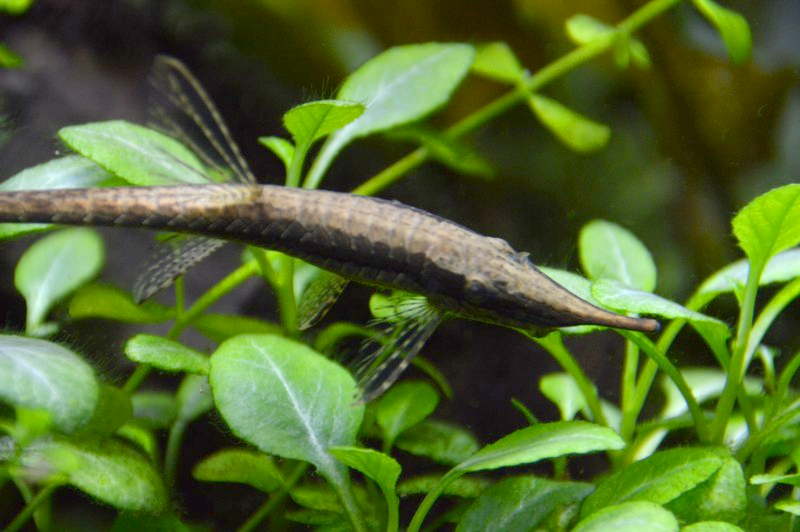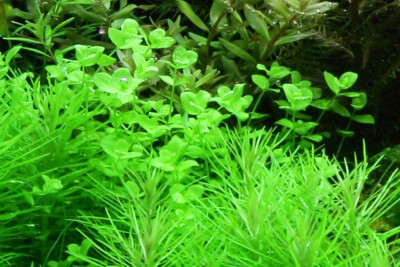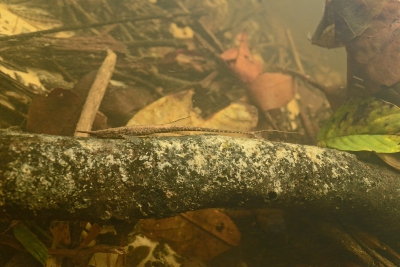twig catfish
| Scientific name | Farlowella vittata |
|---|---|
| Descriptor | Myers |
| Year of description | 1942 |
| IUCN category (World) | LC |
| Family | Loricariidae |
| Genus | Farlowella |


Introduction
Farlowella vittata is a tropical fish native to South America.
Who is it?
Morphology
-
Average size16 cm
-
Maximum size20 cm
-
Longevity8 year
-
ShapeCatfish
-
Average size16 cm
-
Maximum size20 cm
-
Longevity8 year
-
ShapeCatfish
How to recognize This fish ?
The twig catfish is a fish with a curious shape that resembles terrestrial stick insects. It looks like a twig, with very fine scaled body.
Farlowella vittata belongs to the Farlowella acus group described by Retzer and Page, mainly found in the Orinoco basin and the coastal basins of the Rio Yaracuy. Like most Farlowella species in the Orinoco basin, the twig catfish seems to be a migratory species that retreats to larger rivers such as the Orinoco or Apure during the dry season.
It is mainly imported from Colombia and is the most commonly encountered Farlowella species in the aquarium hobby. It is regularly marketed under the name Farlowella acus, a species found only in a small area near Lake Valencia and threatened by pollution from the industrial parks of Valencia and Maracay.
Sexual dimorphism
In fact, Farlowella vittata refers to 4 species of Farlowella, the Farlowella angosturae, Farlowella guaricensis, Farlowella agustini, and Farlowella roncalli.
These 4 species present differences in terms of pigmentation, but also in terms of habitat, as the Farlowella agustini are mainly found in fast-flowing waters on rocky substrates while the Farlowella guaricensis are more often found in vegetation or carpets of dead leaves in calm water sections.
All 4 species, however, share two rows of bony plates on the abdomen.
Behaviour & Life cycle
-
dietherbivorous
-
Sociabilityliving in small groups
-
territorialNo
-
Way of livingnocturnal
The twig catfish is a fish that lives in small groups. It has a calm temperament. Generally, like other Farlowella species, it does not pay much attention to other species. This fish spends most of its time camouflaged in vegetation and on wood but can quickly move if needed.
It is a fish that primarily lives at night. Usually, it leaves its hiding place and becomes active once dusk arrives, but it is not uncommon to observe it during the day as long as the light exposure is not too strong and it feels safe in its environment.
Reproduction
-
Reproductionovipare qui pond sur substrat caché
The twig catfish is an oviparous fish that spawns on hidden substrate. The spawning generally takes place on a flat surface that will be cleaned by the parents beforehand.
The female lays regular batches of eggs interspersed with resting phases close to the male who fertilizes them. The process repeats until all eggs are laid and fertilized. The female will move away from the spawning site, leaving the male to guard and fan the fry for about ten days.
The growth of the fry is very rapid in the first weeks and slows down from the third month.
Harmless species
This species does not represent any particular threats to humans when encountered in its natural environment.
Origin and distribution
Conservation status of populations (IUCN)
What is its habitat?
Natural environment characteristics
-
Temperature24 - 26 °C
-
pH (acidity)6 - 7
-
gh (hardness)3 - 8
-
FlowStrong
Biotope presentation
The twig catfish naturally resides in slightly acidic water.
Depending on the species, Farlowella vittata prefers clear fast-flowing water with rapids, or calm water areas rich in vegetation near the banks.
Species of the same biotope
Main recommendations for fishkeeping
Deontology
In order to preserve wildlife, if you acquire this animal, it must not be released into the wild. See also, the Fishipedia charter.
Fishipedia supports the practice of responsible and environmentally friendly aquarium keeping. We encourage maintenance if it is motivated by a desire to understand the biological functioning of living things and if it is done with respect for animal life.
We believe that aquaristics is an opening to the discovery of aquatic environments, especially freshwater, and that this knowledge is necessary to better protect and respect these environments. Logically, we refute the compulsive purchase of animals that would not find a sufficient and / or adapted place in the host aquarium.
Our recommendationsThese tips apply to adult species from breeding. With regards to water conditions, wild species or close relatives must be kept under the same conditions as in their area of origin.
-
Min volume240 liters
-
Population min5
-
Temperature24 - 26 °C
-
pH (acidity)6 - 7
CharacteristicsThe characteristics below apply for adult species. They correspond to an average of cases, validated in maintenance condition.
-
Difficulty breedingThe farming difficulty is relative. It depends on experiments already carried out with similar species. First, it takes into consideration the robustness of the species, the ease of recreation of a favorable environment and the general behaviour with the other inhabitants of the aquarium.hard
-
Robustnesssensible
-
Behaviourpeaceful
-
Availabilityoccasional
Recommended equipment from our partners
-
Aquarium
-
Filtration
General reminders
It is strongly advised to read the complete dedicated file and to get information on the feedbacks of maintenance of the envisaged animal, this to avoid any potential conflict whose end result is generally the death of the individual (or the other inhabitants). It is important not to overload your aquarium to limit pollution. This will make maintenance easier.
In nature, animals are subject to weather conditions and live in waters with variable characteristics. The recommendations offered by our team for aquarium maintenance are a guidance and cannot be assimilated to scientific datas.
General reminder on maintenance datas
Le démarrage d'un aquarium est une partie primordiale pour l'équilibre et le bien-être des poissons. Lorsque l'on met en eau un aquarium, l'eau passe naturellement par un cycle biologique : le cycle de l'azote. Celui-ci dure environ trois semaines. Tous les 2 jours, nous vous conseillons de tester votre eau jusqu'à ce que le taux de nitrite soit à zéro pendant plusieurs jours d'affilée.
Pour accélérer ce cycle, vous pouvez utiliser un activateur de bactéries comme JBL Denitrol. Cette solution riche en bactéries vivantes et enzymes permet une mise en place rapide du cycle de l'azote. Les poissons peuvent alors être introduits plus rapidement.
Il est important de tester l'eau de son aquarium régulièrement pour maintenir un environnement sain pour les poissons et les autres habitants. Les tests d'eau permettent de mesurer les niveaux de différents paramètres tels que le pH, la dureté totale, ainsi que les taux de nitrates, de nitrites et d'ammoniaque.
Pour réaliser ces tests, vous pouvez utiliser des produits d'analyse spécialisés tels que JBL ProScan qui permet de réaliser un diagnostic de l'eau directement via un smartphone. Il existe également des coffrets de tests plus classiques de bandelettes, comme JBL PROAQUATEST.
En cas d’usage de l’eau du robinet, vous pouvez utiliser un conditionneur d’eau de type Biotopol de JBL pour éliminer les substances nocives comme le chlore, le cuivre, le plomb et le zinc. Les conditionneurs d'eau garantissent une meilleure santé aux poissons et une meilleure croissance des plantes.
Chlorine and chloramine are dangerous for the health of animals. Used to disinfect water, these agents are present in significant quantities in tap water. We recommend using an anti-chlorine agent every time you change the water. In addition to chlorine, treatments and medicines sold for aquarium use sometimes contain dangerous heavy metals in high doses.
Specific needs for the twig catfish
The twig catfish is a species which lives naturally at a temperature between 24 °C and 26 °C. For proper maintenance, the temperature should never exceed the 29°C for long periods. The twig catfish is sensitive to abrupt changes in parameters as well as to chemicals. Its acclimation in an aquarium must be done with special care to prevent it from developing diseases or weaknesses. Nitrate levels should remain below 25mg/L. To keep the water clean and unpolluted, plan on changing 20% to 30% of the water volume each month.
The twig catfish is a species whose maintenance is rather reserved for informed aquarists . It can only be successfully carried out by carrying out a minimum of documentation work. Special husbandry conditions can easily lead to the death of the species or other animals.
This species is generally available in specialized shops or from aquarium clubs. Specimens that have been bred for a long time are easier to breed, but special water parameters must be respected.
Cohabitation & Environment
Being a living in small groups fish, it is advisable to install at least 5 individuals in an aquarium of 240 liters minimum (for 100 cm of frontage). Group maintenance is a prerequisite to ensure their well-being. Lonely individuals tend to quickly become stressed and become especially susceptible to disease. Although sometimes certain groups can "merge", mixing several gregarious species living in the same zone of life is not recommended if the volume is not consequent.
The twig catfish is a peaceful species that generally does not exhibit behavioral problems in a community aquarium.
As previously said, The twig catfish is a species that lives naturally in the current. Thus, we advise the installation of an oversized filtration system (10 to 20 times the volume of the tank) in order to guarantee a strong current and especially a strong oxygenation. A venturi system will improve the dissolved oxygen rate during summer.
The species enjoys a particularly vegetation-rich environment. The addition of plants will provide many useful hiding places for resting. These areas are also conducive to possible breeding in the aquarium.
Tips for feeding
The twig catfish is herbivorous.
This species does not appreciate being fed with freeze-dried food (flakes...). Some specimens will never eat this type of food.
You should not overfeed your residents to avoid polluting the water. For most species, it is better to feed a few small portions each day rather than one large meal.
Food recommendations from our partner JBL - Products PRONOVO
-
Sticks
Reproduction protocol
-
Maintenance difficultymoderate
-
egg-laying protectionYes
Hybridization risks
In general, it is advised not to mix several species of the same genus or different varieties of the same species, to avoid the risks of hybridization.
These animals might interest you
These plants might interest you
Plants play a crucial role in aquariums, both for their ability to filter water by absorbing excess nutrients and for their aesthetic contribution. They provide fish with natural hiding places, can serve as breeding sites, and generally help maintain the overall balance and optimal conditions of the aquarium. The selection presented here includes species from the same regions as the species described on this page, although they do not necessarily come from its exact natural biotope.
To go further
Sources & Contributions
Participation & Validation
The Fishipedia team and specialist contributors are committed to providing high-quality content. However, although the information comes from scientific sources or testimonials from specialists, the cards may contain inaccuracies.

Damien Boulard
Translation
Translation done with the valuable contribution of our translators, who make this information available to a wider audience. We sincerely thank them for their commitment.
Scientific partners
Tags
Species of the same family
Same genus
Species of the same biotope

































